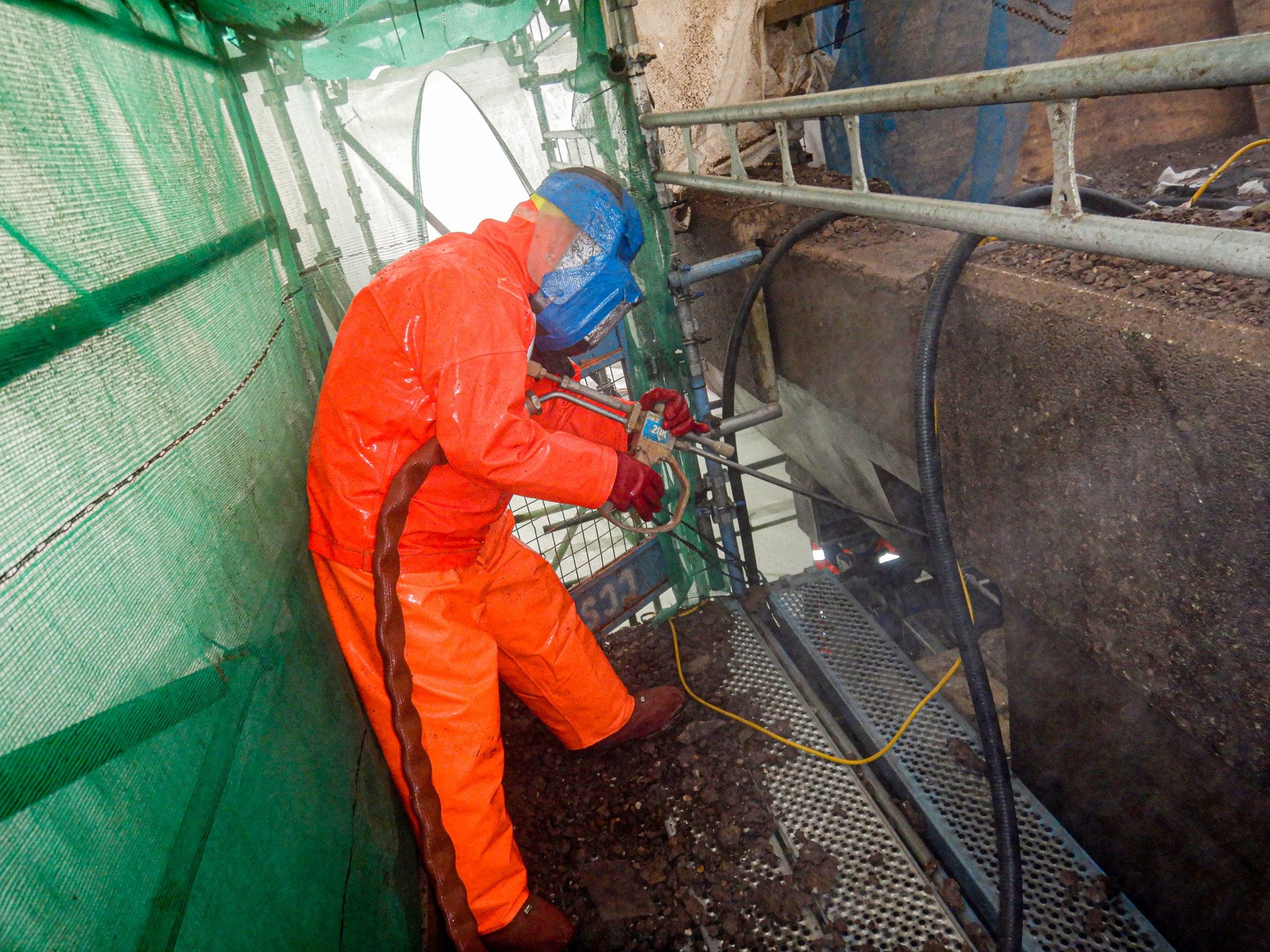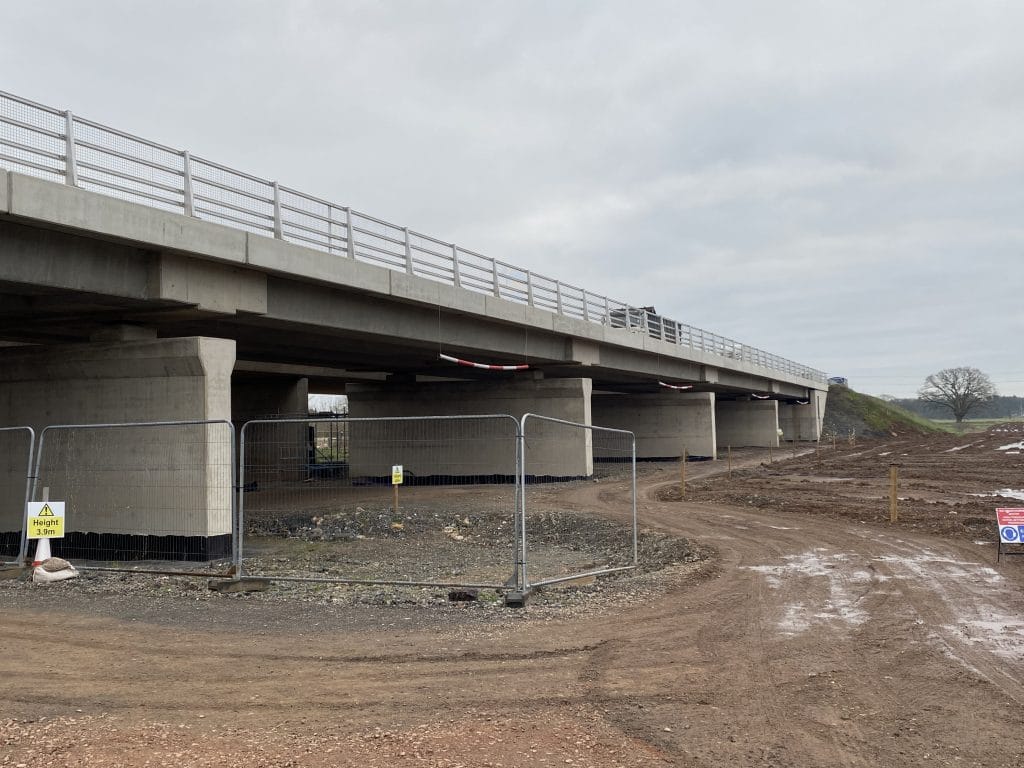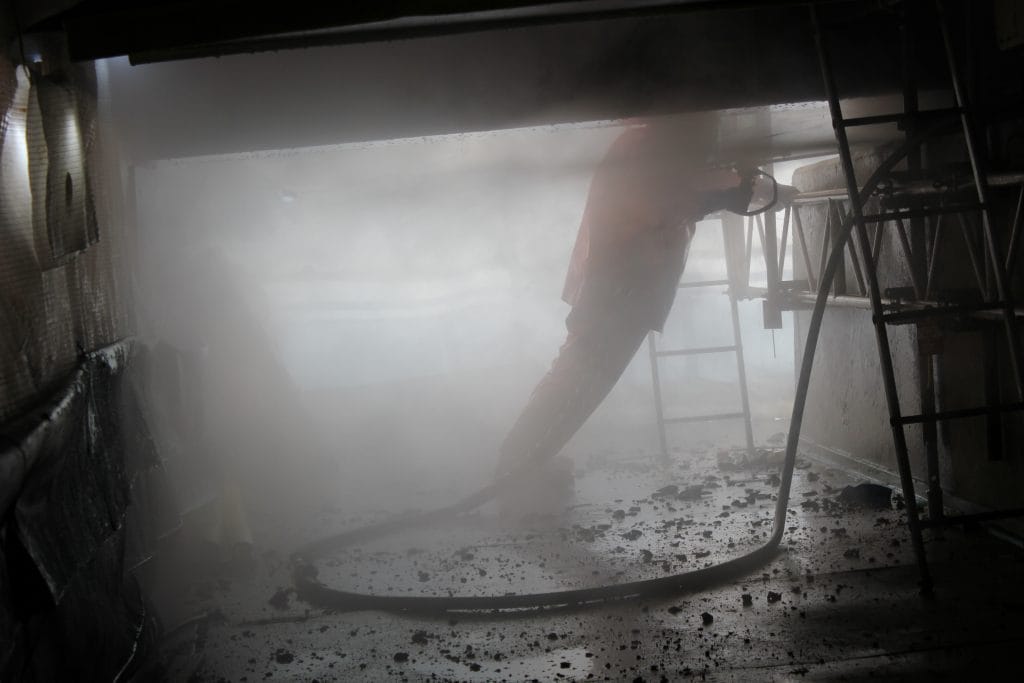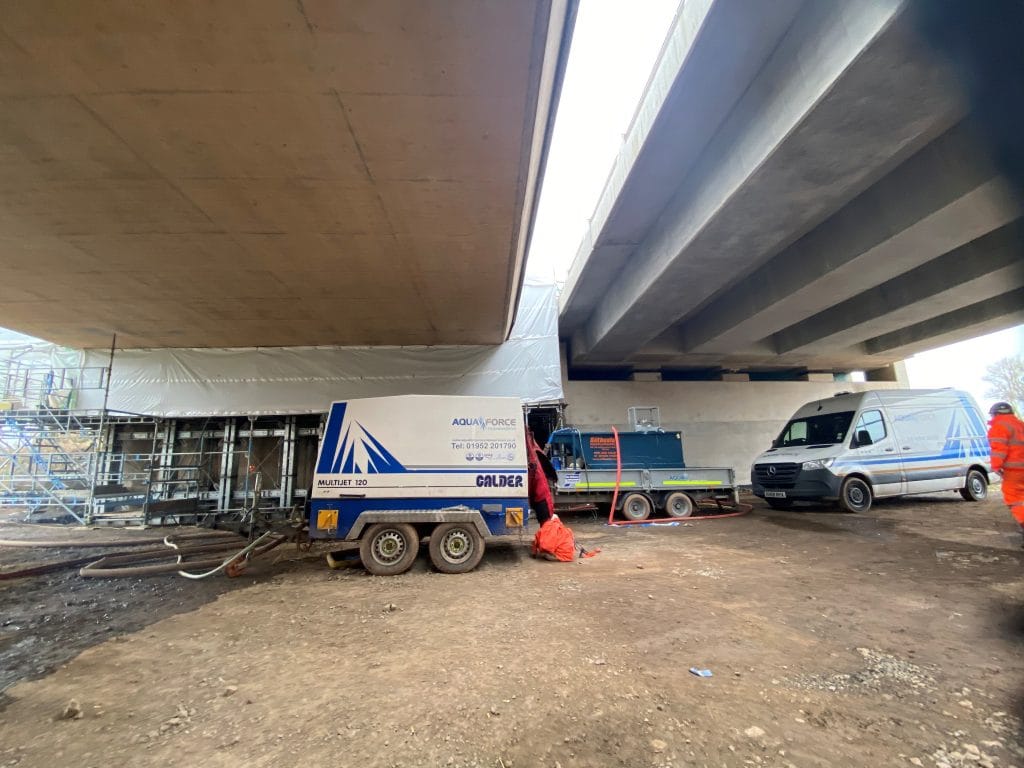Soft power – hydrodemolition gets tough on concrete

We drink it, swim in it and get rained on by it. Get water up to twice the speed of sound, and you can smash through concrete with it as well.
The destructive power of water is playing a vital role in a highway improvement project along one of the busiest roads in the West Midland region.
Jets of water travelling at supersonic speeds are blasting concrete from around bearings beneath two flyovers on the A4440 Southern Link Road near Worcester.
It is an example of how hydrodemolition is increasingly used to support highway maintenance.

Sustainable demolition
With concern about the risks associated with mechanical tools, for example hand-arm vibration, a move to more sustainability solutions, and the need to maintain the UK’s growing (and ageing) road network, its advantages are more relevant than ever.
The hydrodemolition project on the A4440 is being led by Aquaforce Concrete Services, working for its parent company, civil and structural engineering specialist Freyssinet.
Freyssinet is carrying out concrete repairs on the existing roadway on behalf of main contractor Alun Griffiths (Contractors) Ltd.
Worcestershire County Council is overseeing the £62m scheme to upgrade a 3.5-mile section of the link road connecting the M5 with south and west Worcester, Great Malvern, Ledbury, Upton and Herefordshire.
The project, now nearing completion, has seen the phased dualling of the carriageway and the repair and upgrading of the in situ roadway, including two raised sections over the River Severn and its flood plain.
Hydrodemolition advantages
Aquaforce, a member of the Water Jetting Association (WJA), has been working with Freyssinet to release 56 bearings on four abutments and 10 piers along the two flyover sections.
Freyssinet engineers jack up the carriageway to unload the bearing. Aquaforce operatives remove the concrete. The bearing can be removed. Concrete is reinstated, and a new bearing installed.
Their success demonstrates the advantages of hydrodemolition in supporting highway maintenance tasks, said Aquaforce General Manager Gavin Thomas, a member of the WJA’s technical committee.
He added: “Our operatives generally experience much less hand arm vibration than is caused by mechanical tools, and water jetting causes no vibration damage to the structures we work on.
“Particles released are held within water, so dust pollution and highway visibility hazards are reduced. Also, rebar is not damaged and surfaces need little or no further preparation before being reworked, saving money and time.”

Impressive precision
The water jetting operatives show impressive precision, removing just the right amount of concrete and no more. But it is a truly fearsome process.
The jets are so powerful that they can tear lumps of concrete bigger than a fist from around the bearings, exposing the steel rebar for the first time since the carriageway was built.
For this project, Aquaforce’s operatives are using jetting guns set at an average pressure of 1100 bar. Part of their skill involves leaning in to the considerable jetting force. It is as much about balance as strength.
Each operative works on the gun for as long as they can comfortably control it before rotating with a colleague.
Hydrodemolition is always carried out within encapsulated scaffolding, or tented enclosures if operatives are work on carriageway slab.
Ballistic PPE technology
This contains the thousands of shards of concrete removed from the structure. Visors have to be regularly changed because they become so scratched by the bombarding debris.
Beneath their waterproof overalls, the operatives are wearing full body suits made from materials otherwise found in bulletproof vests.
The 10m3 of water needed by each team every shift is collected by an Aquaforce tanker from a nearby standpipe and delivered to site.
Wastewater is filtered to remove a significant percentage of suspended solids and pH balanced on site to ensure it can be disposed of safely and correctly.
Aquaforce is using trailer-mounted high pressure water pumps supplied by Calder, also a WJA member, manufactured just down the road from the A4440 worksite, on Worcester’s northern outskirts.

Unmatched productivity
Each abutment and pier has four bearings. On average, one bearing can be undermined ready to be released every shift, a task that involves removing approximately one metre cube of concrete.
It is a level of productivity that no other methodology is likely to match, which is why hydrodemolition is now the standard method to release bridge bearings in the UK.
It is also used widely to rehabilitate sections of slab, where they have been damaged by road salt and other chemicals, or which need to be prepared for surface dressing with asphalt.
For example, hydrodemolition, carried out by WJA members Sabre Jetting Services and Buxton Water, was vital during the £100m project to repair the M5 viaduct in Oldbury, West Midlands.
Robotic jetting systems
Increasingly, robotic hydrodemolition systems can be used. These have the advantage of removing larger sections of concrete more quickly. Robotic water jetting is also safer than using hand guns because the operative is moved away from the water jet.
Given the unhospitable environment created by the hydrodemolition process, whether using jetting guns or robots, it is little wonder that a key consideration, as the process has become more important, is safety.
Supported by the WJA’s blue code of practice for high and ultra-high pressure water jetting, hydrodemolition has an excellent safety record.
However, the enormous power of water jets, which can reach operational pressures greater than 2,800 bar (40,600 psi), means there is no room for complacency.
Training central to safety
As well as wearing the latest water jetting PPE, for Aquaforce and other hydrodemolition contractors, training is central to maintaining safety and quality standards.
The WJA is the main provider of water jetting training in the UK. Its two-stage training process gives operatives the fundamental knowledge and skills they need to begin their water jetting careers.
A class-based one-day safety awareness course grounds operatives in safe and effective operational procedures.
To qualify for a WJA water jetting card, they must then attend at least one practical module. They are also one-day courses and it is no surprise that there is one for hydrodemolition.
All the courses are accredited by City & Guilds. And to maintain WJA registration, safety awareness must be refreshed every three years.
Competency training
The WJA is now enhancing standards further still, with the world’s first competency qualification for water jetting.
Accredited by ABBE, the Level 2 Water Jetting Technician Certificate, adds a substantial period of work-based assessment (at least a year) carried out by a WJA-approved assessor, to establish that operatives have a higher level of understanding embedded in operational behaviour.
In its latest initiative, the WJA is seeking to support high pressure washing standards with the introduction, in 2022, of a new code of practice for pressure washing.
New purple code
Named the ‘Purple Code’ thanks to its purple cover and will, it will set out best practice for low pressure water jetting procedures and support learning in the WJA’s pressure washing training course.
WJA Training and Safety Committee Chairman Darren Hamilton said: “We’re expecting construction contractors, who use pressure washing widely, to welcome our code of practice, which will help underpin safety and operational performance.”
